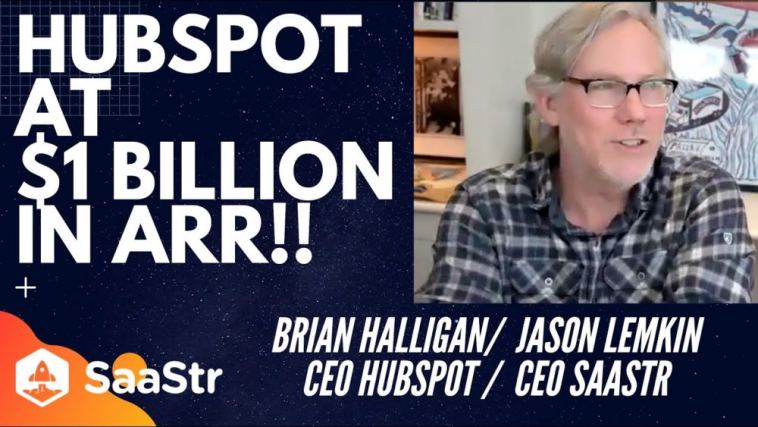- Like
- SHARE
- Digg
- Del
- Tumblr
- VKontakte
- Flattr
- Buffer
- Love This
- Save
- Odnoklassniki
- Meneame
- Blogger
- Amazon
- Yahoo Mail
- Gmail
- AOL
- Newsvine
- HackerNews
- Evernote
- MySpace
- Mail.ru
- Viadeo
- Line
- Comments
- Yummly
- SMS
- Viber
- Telegram
- JOIN
- Skype
- Facebook Messenger
- Kakao
- LiveJournal
- Yammer
- Edgar
- Fintel
- Mix
- Instapaper
- Copy Link
In this SaaStr insider episode, SaaStr CEO and Founder, Jason Lemkin catches up with Brian Halligan, CEO and Co-founder of HubSpot. Together they discuss: why partners are a moat, why HubSpot avoided going more enterprise, building vs. buying, and building an eco-system. Here are some of our top learnings from the discussion:
Why Partners Are a Moat
50% of Hubspot’s 100,000 customers want to deploy the product themselves, while the other half buy through an agency partner or a CRM implementer because they need the help to set up the platform and deploy their campaigns.
With a partner pool of about 5,000, they now have a good-sized channel that takes care of customers without HubSpot having to allocate resources to taking care of them themselves. In fact, the retention rate of their customers that come through partners is better than the retention rate of our customers that come through the direct channel.
So why isn’t HubSpot trying to take this revenue stream in-house?
Halligan: “Marketers like services. I mean, you look at any marketing budget and there are so many agencies doing different things. You can very easily get wrapped up in doing all of these services. And our early customers wanted us to do all like, ‘Can you write our blogs for us? Can you do our social media posts?’ They wanted us to do all that stuff, but we kind of flipped it and said, actually, we can turn this into an opportunity and build a partner channel and build a big community around this, which is a big moat and enable them all to just sell it. And so that’s kind of how we started it.
We could have easily built a giant services company. Dharmesh and I knew a lot about services and a lot about how to do SEO and content marketing. We could have easily done it, but it would have been a bad move.”
Not Leaning Heavily on Enterprise
Even as HubSpot has now reached $1B ARR and added more feature functionality over the years including CRM, support, and full suite support, their ARPU (average revenue per user) has actually remained at about $10,000. It’s a unique way to build a unicorn SaaS business.
HubSpot leaned in hard in the early days with heavy freemium and relied on making it easier for businesses to start with a low-price point and then work their way up to pro and then to enterprise. But as they were winning deals against other CRMs in the space like Marketo and Eloqua, their investors and board were tempted to move more upmarket and chase higher ACVs.
Halligan: “Everyone around us was tempted. But we were not. I think we were right about our target market. Everyone else in the world, even now our big investors ask us now, ‘when are you going to go sell to the Fortune 500?’ We always thought that there’d be a giant market down below that Fortune 500 for startups that wanted to scale from 2 employees to 2000 employees and build a killer product for those people. And our thesis was that historically no one made money in that because you couldn’t sell to them.
And our thesis was really obvious in that retrospect, that you could dramatically drop tack by using consumer-like marketing techniques, inbound marketing, content marketing, freemium, to get to these people. And so I think we were right about that for a long period of time. And lots of other people were wrong. But you have to get the math right to pull that off. And it took us a long time to get the math right.”
Want more? Enter your email below for the latest SaaStr updates
Building an Ecosystem
As their key customers, marketers have a lot to keep track of and wrap their heads around. Sure, they’re using HubSpot as the “hub” of their marketing, but it still has to plug-in to, on average, about +20 or so more apps to centralize the data. So marketers are racking up a hefty mar-tech bill for their complete marketing ecosystem, and HubSpot becomes a small slice of the entire eco-system. In fact, HubSpot’s partners are bringing in about 2x the amount of HubSpot itself, so their partners are using it as a multiplier.
Halligan: “The ecosystem has evolved. There are different types of partners who get this. We obviously integrate with Facebook and Google, and then we have newer venture-backed startups like Hoppin and Bevy, but then we’re starting to see more and more companies just start on HubSpot. More and more entrepreneurs are building their whole business around us. But the other thing that’s happening that’s interesting is a lot of these partners we work with are just extending HubSpot in amazing ways with one-off things building on top of HubSpot. That is mushrooming in our ecosystem as well.”


